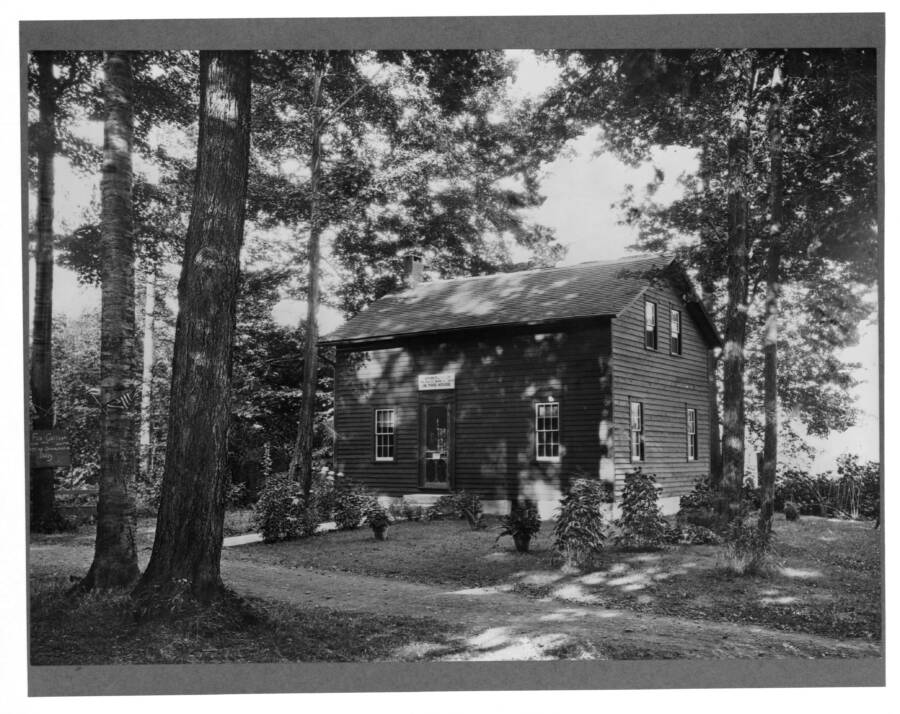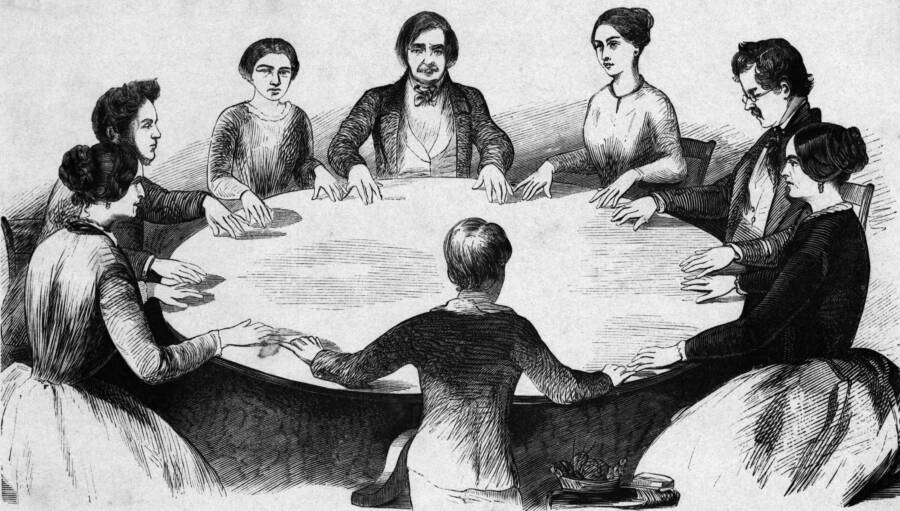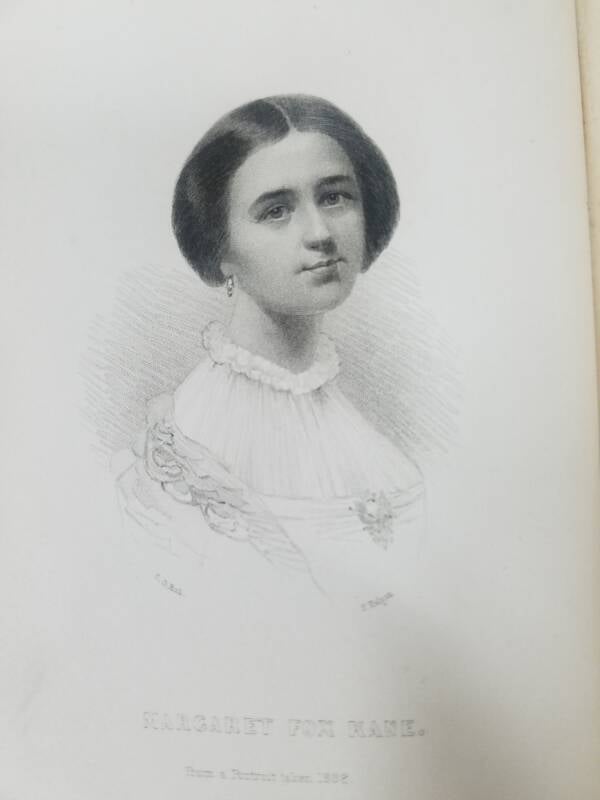Leah, Kate, and Maggie Fox carried out an elaborate prank for 40 years, convincing audiences that they could communicate with spirits.

Lithograph by Currier and Ives/Getty ImagesThe Fox sisters, Margaretta “Maggie,” Catherine “Kate,” and Leah.
In 1848, the small town of Hydesville, New York, wasn’t known for much. But in April of that year, residents began flocking to a tiny farmhouse to witness the strange powers of the Fox sisters, Maggie and Kate, who seemed to be able to conjure spirits who rapped mysteriously on the walls.
As astounded neighbors watched, the girls seemingly coaxed spirits from the netherworld to respond to a series of questions by rapping out an answer. Before long, Maggie and Kate’s sister, Leah, began touring them all over the state, where the ghostly “raps” shocked audiences.
But Maggie and Kate had a secret. The raps were actually produced through a technique they’d developed by cracking the joints in their toes and feet. And though the Fox sisters launched the Spiritualism craze in the United States, they’d soon denounce it as a fraud.
The Mysterious Haunting In Hydesville
Night after night in a small farmhouse in Hydesville, New York, a ghost seemed to appear once the family went to bed. It made terrific noises in the darkness, pounding out “raps” on the house’s walls and furniture. But the ghost wasn’t an evil spirit — it was the Fox sisters, 14-year-old Maggie and 11-year-old Kate.
According to HistoryNet, the sisters had devised a way of making loud noises with their toes. By cracking their joints and snapping their big and second toes together against wooden floors or furniture, they could create a sound loud enough to wake their parents. Their mother, Margaret, was frightened; their father, John, was dubious.
The sisters thoroughly enjoyed the prank. But on March 31, the situation spun out of their control. That night, as the raps began, Kate suddenly clapped her hands twice and cried: “Mr. Splitfoot, do as I do!”

Library of Congress/Corbis/VCG via Getty ImagesThe Fox home in Hydesville, New York, where American Spiritualism was born.
The “ghost” responded with two raps. Margaret Fox then engaged in a sort of discussion with “Mr. Splitfoot,” asking it to tell her how many children she had (six raps), if it were a spirit (two raps, yes), and if it had been injured in their farmhouse (two raps, yes).
The male “spirit” explained through raps that he had once been a peddler. Five years earlier, he said, according to the Paris Review, someone had murdered him for $500 and buried him beneath the Fox family’s farmhouse.
Margaret Fox promptly summoned the neighbors to hear the raps for themselves. According to the The Reluctant Spiritualist: The Life of Maggie Fox, the Fox sisters were horrified at the sudden turn of events. As Maggie later wrote, they only continued the ruse because they thought that confessing would get them in trouble with their parents and their preacher.
With no other choice, the Fox sisters repeated their performance for their incredulous neighbors that night, and the next. Before long, word about the strange, ghostly rapping began to spread beyond Hydesville.
Still, Maggie and Kate might have been dismissed as a strange curiosity if their sister Leah hadn’t gotten wind of what was happening. She swiftly traveled to Hydesville from her home in Rochester, apparently determined to turn her sisters’ trick into a fortune.
The Fox Sisters And The Rise Of Spiritualism

Bettmann/Getty ImagesA depiction of 19th-century “table rapping” as popularized by the Fox sisters.
By the time the Fox sisters started cracking their toes to scare their parents, interest in the “beyond” was at an all-time high. The ideas of figures like Emanuel Swedenborg, an 18th-century Swedish mystic, and Andrew Jackson Davis, a 19th-century American “seer,” had started to gain hold across the United States.
Swedenborg believed that spirits existed across different “planes” and claimed to have seen and talked to them. Davis took Swedenborg’s ideas one step further and wrote that “spirits commune with one another while one is in the body and the other in the higher spheres.”
At the same time, new technologies like the railroad and the telegraph were transforming the United States. The world was different and strange, and many Americans didn’t think that communicating with the dead was much more bewildering than communicating with someone across an ocean.
Then came Leah Fox, who saw a chance to capitalize on the new interest in spirits with her sisters’ prank. According to the Paris Review, she promptly started charging audiences one dollar to see them communicating at her home in Rochester, New York. Maggie and Kate had confessed the truth to her, and they felt they had no other choice than to obey her commands.
Despite skeptics, the Fox sisters’ act rapidly spread. After performing in upstate New York, they soon moved to bigger audiences in New York City.
“We are in the dark as any of our readers,” wrote George Ripley of the New York Tribune, according to HistoryNet, after seeing the Fox sisters. “The manners and bearing of the ladies are such as to create a prepossession in their favor. They have no theories to offer in explanation of the acts… and apparently have no control of their incomings and outgoings.”
According to the Paris Review, “rapping” became a nationwide phenomenon by 1850. As the Fox sisters performed their feat for figures like abolitionist William Lloyd Garrison and New York Tribune editor Horace Greeley, men and women across the United States claimed to be able to do the same.
As a result, between 1853 and 1855, millions of Americans came to believe in Spiritualism. But the movement had one significant nonbeliever: Maggie Fox herself.
Were The Fox Sisters A Fraud?

Public DomainMaggie Fox later denounced Spiritualism as a fraud, though she recanted her confession a year later.
When she was 17 years old, Maggie Fox found something more powerful than fame or spirits: love. As the Paris Review writes, she met Elisha Kane in 1852 and fell hard for the young explorer. Kane, a skeptic, urged Maggie to give up her “life of dreary sameness and suspected deceit,” according to Smithsonian magazine.
Maggie promptly retired, but Kane’s death five years later threw her into a deep depression. As Maggie began to drink heavily, Kate continued to practice Spiritualism, which saw another boost in popularity during the dreary and death-filled Civil War years. But the work began to grate on Kate, and she also became an alcoholic.
By 1888, both sisters were disillusioned by the movement — and Maggie decided to denounce Spiritualism once and for all. Perhaps, as Smithsonian magazine notes, she was motivated by anger at Leah and other Spiritualists, who’d critiqued Kate for her drinking. But perhaps Maggie simply wanted to put their decades-long lie to bed.
“My sister Katie and myself were very young children when this horrible deception began,” Maggie announced on stage on Oct. 21, 1888, in New York City, according to Salon. “We were very mischievous children and sought merely to terrify our dear mother, who was a very good woman and very easily frightened.”
Then she ripped back the curtain on the Fox sisters’ act. According to Maggie, she and Kate had simply learned to loudly crack their toes. As the audience watched, she even demonstrated how it worked.
“A great many people when they hear the rapping imagine at once that the spirits are touching them,” Maggie added. “It is a very common delusion. Some very wealthy people came to see me some years ago when I lived in Forty-second Street and I did some rappings for them. I made the spirit rap on the chair and one of the ladies cried out: ‘I feel the spirit tapping me on the shoulder.’ Of course that was pure imagination.”
In the aftermath, Leah claimed that Maggie was simply an attention-seeker who’d denounced Spiritualism for a $1,500 speaking fee, according to the Paris Review. And, indeed, Maggie recanted her confession just a year later.
“At the time I was in great need of money and persons… took advantage of the situation,” she said, according to Salon. “The excitement, too, upset my mental equilibrium. When I made those dreadful statements I was not responsible for my words.”
By then, the Spiritualism movement had become much bigger than the Fox sisters. They died — Leah in 1890, Kate in 1892, and Maggie in 1893 — without any fanfare. Since then, their spirits have been much quieter than the Fox sisters were in life, with no rapping, not a peep, to be heard.
After reading about the Fox sisters, look through these facts about the Victorian age. Or, delve into the trend of “spirit photography.”





